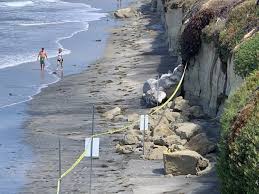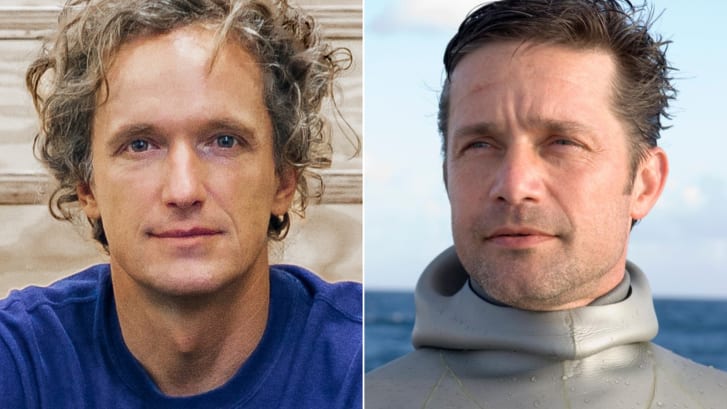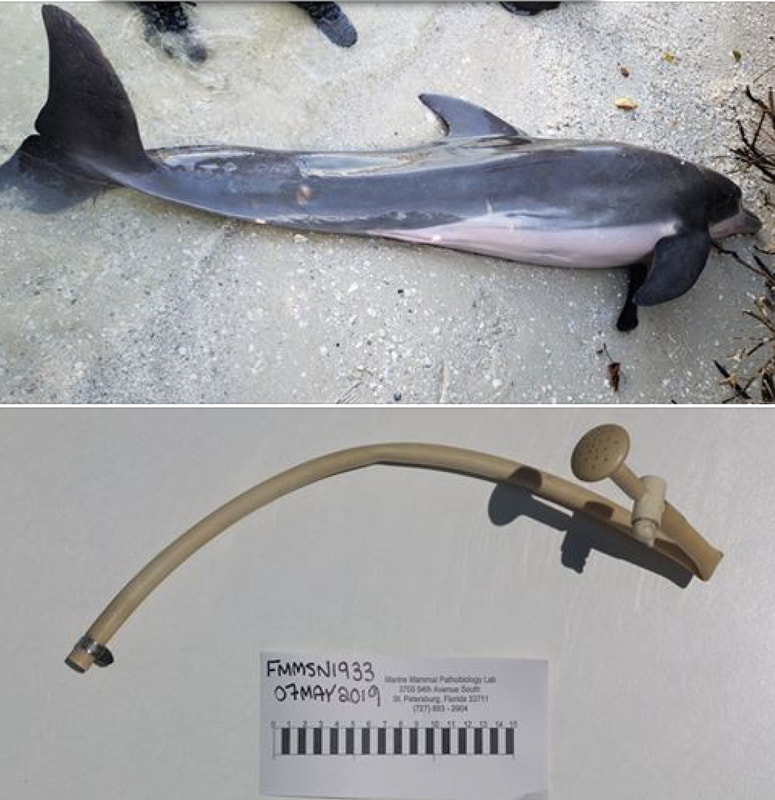|
Surfing advocates and California’s Coastal Commission rained ire this week on a bill that would allow San Diego and Orange county homeowners to build seawalls by right, sidestepping commission oversight. Seawalls are highly controversial in California, viewed as a property defense against sea-level rise and the crumbling of coastal cliffs. At the same time, seawalls prevent the natural replenishment of beach sand from cliff faces and land runoff. Republican Sen. Pat Bates, who represents portions of San Diego and Orange counties, brought SB 1090 before the Senate Natural Resources and Water Committee allowing testimony from pre-selected speakers. The father of an Encinitas family that lost three members when a cliff collapsed on top of their weekend picnic last year gave emotional testimony on behalf of the bill. “There is no plan for sand replenishment or any other bluff changes to increase safety on this very popular stretch of beach where my accident occurred,” said J. Patrick Davis, a pediatric dentist. Seawalls, or “hard armoring” as Surfrider Foundation’s scientist Jennifer Savage called the structures, do not make beaches safer, she said. “They destroy the beach by speeding-up erosion,” Savage said.  The Coastal Commission representative argued the Encinitas incident was a tragic accident, not due to a lack of action by the commission to approve or deny a seawall in the area. “The bill is designed to make it faster, easier and cheaper to build seawalls primarily to protect private residential development,” Sarah Christie, the commission’s legislative director, testified. “For every seawall that is built, the public loses a beach.” There was no committee vote, however. Sen. Henry Stern, the committee chair, and Bates agreed ahead of time to hear the bill without the vote, and testimony was heard on May 26, 2020. said Josh Kirmsse, Stern’s communications director. The Committee Analysis states that for Orange and San Diego Counties, this bill would effectively authorize by-right construction of sea walls/other hard shoreline structures and only allow the commission or a local government to deny an application for a shoreline protective device only if they determine that the construction of a shoreline protective device would constitute a substantial threat to the public health or safety. It also seeks to prohibit a state agency or local government to adopt an ordinance, regulation, policy or rule that is inconsistent with these requirements. Supporters of the bill include California Apartment Association, California Association of Realtors, Newport Beach Association of Realtors, North San Diego County Association of Realtors, Oceanside Chamber of Commerce, Orange County Realtors, County of San Diego, and ‘four individuals’.  Marce Gutierrez-Graudins Marce Gutierrez-Graudins Opposers to the bill included Azul. Azul was founded in 2011 by Marce Gutierrez-Graudins, to bring Latinxs perspectives and participation to ocean conservation, and are legally organized under the Trust for Conservation Innovation. After experiencing how mainstream ocean conservation efforts and campaigns were leaving Latinxs out, Marce decided to start Azul to engage her community in protecting coastal resources and marine life. In a joint sign-on letter expressing strong opposition, Azul, among others, writes that SB 1090 “would pave the way for private property owners to effectively hasten and accelerate the loss of public beaches from the Orange County and San Diego coasts under the guise of claiming to improve public safety.” Others who registered in opposition to the bill were California Coastal Protection Network, Heal the Bay, California Coastal Commission, California Coastkeeper Alliance, California League of Conservation Voters, California Native Plant Society, Center for Biological Diversity, Clean Water Action, Defenders of Wildlife, Natural Resources Defense Council, Plastic Pollution Coalition, Seventh Generation Advisors, Sierra Club California, Surfrider Foundation, The 5 Gyres Institute, The Center for Oceanic Awareness, Research, and Education (COARE), The Honorable Betty T. Yee, California State Controller, and the Nature Conservancy. Senators will do more work on the legislation at the committee level. The bill analysis also states that erosion will be exacerbated by the presence of sea walls on the seaward size of the sea wall. Public accessibility will be correspondingly compromised. Beaches need natural erosion and sediment transfer for their health. Living shorelines, soft armoring and managed retreat, if necessary, should be prioritized. How can shoreline armoring be “designed to mitigate or protect against coastal erosion” as it is known to exacerbate that very thing? It also comments that the bill provides an implicit public subsidy to private landowners.
Click here for the full bill text.
2 Comments
 Sixty feet beneath the surface of the Caribbean Sea, aquanaut Fabien Cousteau and industrial designer Yves Béhar are envisioning the world's largest underwater research station and habitat. The pair have unveiled Fabien Cousteau's Proteus, a 4,000-square-foot modular lab that will sit under the water off the coast of Curaçao, providing a home to scientists and researchers from across the world studying the ocean -- from the effects of climate change and new marine life to medicinal breakthroughs. Designed as a two-story circular structure grounded to the ocean floor on stilts, Proteus' protruding pods contain laboratories, personal quarters, medical bays and a moon pool where divers can access the ocean floor. Powered by wind and solar energy, and ocean thermal energy conversion, the structure will also feature the first underwater greenhouse for growing food, as well as a video production facility. The Proteus is intended to be the underwater version of the International Space Station (ISS), where government agencies, scientists, and the private sector can collaborate in the spirit of collective knowledge, irrespective of borders.  Industrial designer Yves Béhar (left) and Aquanaut Fabien Cousteau (right) Industrial designer Yves Béhar (left) and Aquanaut Fabien Cousteau (right) "Ocean exploration is 1,000 times more important than space exploration for -- selfishly -- our survival, for our trajectory into the future," Cousteau said over a video call, with Béhar. "It's our life support system. It is the very reason why we exist in the first place." The newly unveiled design is the latest step for this ambitious project. According to Cousteau, it will take three years until Proteus is installed, though the coronavirus pandemic has already delayed the project. Cousteau comes from a family of famous oceanographic explorers. He's the son of filmmaker Jean-Michel Cousteau and grandson of Aqua-Lung co-creator Jacques-Yves Cousteau. The project is a joint effort between the Fabien Cousteau Ocean Learning Center (FCOLC) and Béhar's design firm Fuseproject, as well as their partners, which include Northeastern University, Rutgers University and the Caribbean Research and Management of Biodiversity Foundation. While the project currently has some backing from the private sector, it is currently seeking further funding. Beyond backers, the station's wet and dry labs can be leased to government agencies, corporations and academic institutions. Part of the plan is to offer regular visibility about what is happening on Proteus, including live streams and VR/AR content. In this way Cousteau hopes to engage a wider audience. “Imagine if you found something amazing -- whether it be microcosmic like a pharmaceutical, or macrocosmic like the next greatest animal -- if you could show it to classrooms and universities," he said. "Our mission is to be able to translate complex science into something that the average person not only maybe will understand, but fall in love with."  Based on factors like political stability, corporate governance, risk environment and supply chain logistics and transparency, FM global paired these rankings with their country’s initial response to the virus, and identified the nations across the globe that have a high likelihood of maintaining stability and resilience through the crisis. To capture the United States’ broad geographic footprint, the index split up the country into West, Central and East regions, but as a whole, the US ranked well (9th, 11th and 22nd, respectively) for its low-risk business environment and strong supply chain. Top 10 most resilient countries, according to the 2019 Global Resilience Index 1. Norway 2. Denmark 3. Switzerland 4. Germany 5. Finland 6. Sweden 7. Luxembourg 8. Austria 9. US Central 10. United Kingdom Danish culture, which tends to be trusting of authority and willing to stand together for a common cause, has also had an impact on the effectiveness of the measures. “The word ‘samfundssind’ (which roughly translates to “civic sense” or “civic duty”) is the new buzzword in Denmark on both social and traditional media, and most people feel a moral duty to make sacrifices for the sake of public health,” said Aarup Christiansen. “No-one wants to be called out for being responsible for endangering the lives of senior citizens just because they won’t give up their usual luxuries.” Ranked 12th-most resilient in the index, New Zealand scores especially high in corporate governance and its supply chain. The country has also been able to move quickly to contain the spread of the virus by shutting borders to international travellers on 19 March and enacting a non-essential-business lockdown on 25 March. See the full list here Donors are pouring money and goods into Australian bushfire relief efforts, as organizations struggle to direct the contributions to where they can do the most good. Charity directors say some donors likely have only a vague sense of where their money is going. A Facebook fundraising event for a rural fire service that had a goal of $20,000 took in $34 million, making it the largest one ever on the platform. A fire commissioner said the organization will likely spread around the windfall to fire victims or other fire services. Meanwhile, the Australian Red Cross has raised about $67 million in individual contributions since July 1, compared with $7.5 million during a drought appeal last year. And a wildlife rescue group in New South Wales has raised $9.6 million, likely siphoning off donations to other regions as donors may have thought they were contributing generally to help animals caught in the inferno. Australian philanthropist Andrew Forrest is touring the U.S. seeking support for efforts to prevent and mitigate fire disasters worldwide. He and his wife, Nicola, have pledged $48 million through their Minderoo Foundation in response to the bushfires raging in Australia. The foundation has set up a fire fund to accept donations and hopes to raise more than $344 million for fire-resilience efforts.
 Florida officials discovered a two-foot plastic shower hose in the stomach of a seven-foot-long dead male dolphin that washed ashore earlier this month, CNN reports. The Florida Fish and Wildlife Commission announced on May 17 that the dolphin was found at Fort Meyers Beach a week before. Biologists performed an autopsy, which revealed the hose and other plastic parts in the dolphin's stomach and esophagus. "Your actions can make a difference - secure and properly dispose of trash, take part in coastal cleanups and share information on how to reduce marine debris with others," the agency wrote in a Facebook post. The dolphin is the second stranded one that officials have found at the beach in a month. A months-old dolphin was found on April 23 with a piece of balloon and two plastic bags in its stomach. Biologists determined that it was in poor health and decided to "humanely euthanize" it. "This finding highlights the need to reduce single use plastic and to not release balloons into the environment," the commission said at the time. More than 700 species of marine animals come across litter, much of which is plastic, according to the University of Plymouth. An estimated 12 million tons of plastic waste enter the ocean every year, the institution further notes. Several states have made an effort to limit the use of plastic in response. In 2015, Hawaii became the first to ban plastic bags in all of its counties. California and New York have since followed suit with similar legislation. For more info, click here Ten per cent of the oxygen we breathe comes from just one kind of bacteria in the ocean. Now laboratory tests have shown that these bacteria are susceptible to plastic pollution, according to a study published in Communications Biology.
"We found that exposure to chemicals leaching from plastic pollution interfered with the growth, photosynthesis and oxygen production of Prochlorococcus, the ocean's most abundant photosynthetic bacteria," says lead author and Macquarie University researcher Dr Sasha Tetu. "Now we'd like to explore if plastic pollution is having the same impact on these microbes in the ocean." Plastic pollution has been estimated to cause more than US$13 billion in economic damage to marine ecosystems each year, and the problem is only getting worse with marine plastic pollution estimated to outweigh fish by 2050. "This pollution can leach a variety of chemical additives into marine environments, but unlike the threats posed by animals ingesting or getting entangled in plastic debris the threat these leachates pose to marine life has received relatively little attention," says Dr Lisa Moore, a co-author on the paper. In the first study of its kind, the researchers looked at the effects these chemicals have on the smallest life in our oceans, photosynthetic marine bacteria. For more, click here. Grant Makers Boost Climate-Change Commitments by $3 Billion. Michael Towner, Iconic Legacy.9/14/2018  29 foundations capped the 3 day Global Climate Action Summit in San Francisco with an announcement of $3 billion in new pledges to reduce the rate of global warming. The funds will be deployed over the next five years. The announcement came in response to criticism that philanthropy has chronically underfunded one of the planet’s most vexing challenges. There is no overarching strategy guiding the group of foundations. Each institution plans to attack climate change using its own approach, whether it means developing alternative fuels, "re-greening" deforested lands, pressing for carbon-emission limits, or another strategy. The $3 billion is a "down payment" on increased philanthropic investment, said Charlotte Pera, president of the ClimateWorks Foundation. "There is a strong recognition from the philanthropic community that this issue is both urgent and long-term," she said. "I’m confident that there will be a lot of coordination on how these funds are spent going forward." In 2015, the most recent year for which Foundation Center data is available, less than 1 percent of grants from the nation’s largest 1,000 grant makers went to address climate change. The tide of new spending from institutional philanthropy comes as the federal government has withdrawn efforts to fight climate change. In June 2017, President Trump announced his intention to withdraw from the multinational Paris climate agreement, which laid out pathways to achieve a slowdown in global warming.  The $4 billion total includes a $600 million commitment that the Hewlett Foundation announced in December. That announcement, says Larry Kramer, Hewlett’s president, was part of a 2 year campaign to get other donors interested in the topic. He said it was a signal to other donors that climate change would impact their work even if they do not directly support the environment. Larry Kramer is the current president of the William and Flora Hewlett Foundation and the former dean of Stanford Law School.  Harrison ford delivered a speech at Moscone Center for the Global Climate Action Summit sponsored by California Gov. Jerry Brown. Ford didn't name President Donald Trump in his talk, but some of his comments obviously referred to the U.S. leader. "For God's sake, stop electing leaders who don't believe in science," he said. "Or even worse, pretend they don't believe in science. Never forget who you're fighting for." Michael Towner  For decades, the trail has been a shortcut used by hikers and equestrians traveling between the wealthy ranches of Hidden Valley, on the other side of the hill from Malibu, California, and the miles of dirt paths that traverse the Santa Monica Mountains National Recreation Area. In recent years, however, it has become a battleground between neighbors in an escalating spat pitting public access against private property rights. Like many private neighborhoods abutting the Santa Monica Mountains, it has given rise to fences and “No Trespassing” signs, lawsuits and even a state investigation into claims that a deer carcass was dragged onto the Los Robles trail system to lure mountain lions — and in turn to scare off hikers and horseback riders. “The dead deer on the trail makes this case bizarre, to put it mildly,” said David Szymanski, superintendent of the Santa Monica Mountains National Recreation Area. At the heart of this fight is a trail that cuts through the community of Lake Sherwood — a gated development that has been home to celebrities including Sylvester Stallone and hockey great Wayne Gretzky. David Margulies, 52, a Hidden Valley resident, said he was on horseback in late 2016 when a man warned him that the path was the private property of Sherwood Development Co., a real estate company owned by the billionaire chief executive of Dole Food Co., 95-year-old David Murdock. According to Margulies, the man said he had no right to be there. Soon after that encounter, Margulies was the subject of an illegal grading complaint filed with Ventura County related to trail work on paths on his property linking to those on Sherwood Development property. In April, Margulies filed a lawsuit in Ventura County Superior Court against Sherwood Development, alleging the company has been discouraging public use of the trail as part of an effort to “expedite the development process” and increase the exclusivity and value of the properties it seeks along the hillsides. The trail is visible in aerial photos taken in 1947 — nearly four decades before the community of Lake Sherwood was developed. Given its history, Margulies argues, hikers and horseback riders have what’s known as a prescriptive right to traverse it even though it is on private property. Attorneys for Sherwood Development said in court documents that the applicable statute of limitations has expired to debate public use of the contested trail. It seemed like a run-of-the-mill spat over property rights until the dead deer showed up. While hiking with friends on the morning of Aug. 4, Margulies said he came across a scene that didn't look quite right. A dead deer lay across the trail — but there were no signs of ants or flies on the carcass. On the ground nearby were discarded rubber gloves and fresh tire tracks. Attached to trees were three motion-activated cameras trained on the scene. It looked as if someone had left the deer as bait, he thought, perhaps for a mountain lion. Margulies should know: As the former chairman of the National Geographic Society’s Big Cats Initiative, he is familiar with the way dead prey can be used to lure large predators. Without permission, Margulies examined the photos from the motion-activated cameras, which appeared perfectly angled to capture any scavengers that preyed on the carcass. That episode convinced him to amend the lawsuit last week to allege that Sherwood Development had placed the deer on the trail for two possible reasons, both illegal, he said. Sherwood Development “intentionally and knowingly set the deer at that location to lure mountain lions to my ranch, in order to create danger to me and my family if we used the trails,” the amended lawsuit reads.  The remains of P-55 were found recently in the Santa Monica Mountains. The remains of P-55 were found recently in the Santa Monica Mountains. Or, he alleges, the company “deliberately acted with the intention to do harm to the local mountain lion population” by poisoning the deer. He questions in the lawsuit whether there is a connection to the death of a 3-year-old adult male mountain lion, known as P-55, found a mile away by National Park Service officials in July. As Margulies tells it, there is little doubt Sherwood Development put the deer on the trail. Margulies points to an email he says he received from Jeff Sikich, a federal biologist with the recreation area and an expert on local mountain lion populations, whom he notified soon after discovering the carcass. “I just spoke with Lake Sherwood and they said they placed the deer in front of their remote cameras on their property” in order to photograph the scavengers it attracted, Sikich said in the email, which was forwarded to The Times. Sikich declined to comment. As did Kate Kuykendall, acting deputy superintendent of the recreation area. The California Department of Fish and Wildlife is conducting an investigation into the deer’s death. That includes an ongoing necropsy to determine how the animal died, whether it was hauled to the site and if it was poisoned — perhaps with the intent of harming local mountain lions. “By the time we took control of the deer carcass, it was pretty badly decomposed,” said Patrick Foy, a spokesman for the California Department of Fish and Wildlife. “Our laboratory staffers are not confident we will get good data from the necropsy, which will be completed soon.” In the meantime, a chain link fence and “No trespassing” signs were recently installed along parts of the trail.  David Murdock David Murdock The wealthy ranch communities grew out of the postwar building boom more than six decades ago, when developers transformed rustic retreats into a hub for Los Angeles power brokers and celebrities only an hour’s drive from Hollywood: extravagant mansions, 20-acre lots, clubhouses, golf courses, equestrian trails. Hollywood even helped give Lake Sherwood its name, thanks to a man-made reservoir that served as the backdrop for medieval England’s Sherwood Forest in a “Robin Hood” film in the 1920s. The lake was open to the public for picnicking and boating until the 1980s, when it was drained. In 1985, Murdock bought the lake and refilled it, but he never again reopened it to the public. Today, it is part of the 1,600-acre unincorporated community of roughly 1,500 residents. Murdock’s interests, both personal and professional, extend beyond real estate. Since 1985, he has controlled Dole — one of the world’s largest producers of fruits and vegetables. It’s a business that neatly fits the philosophy of a health and fitness devotee who has said he eagerly awaits a time when scientific breakthroughs allow people to live as long as 150 years. Apparently, he has vowed to live to 125. Murdoch apparently played the role of a reverse “Robin Hood” by taking back control of dole in a $13.50-a-share offer that allegedly undervalued Dole’s stock by more than $10. He was Dole’s CEO from 1985 to 2007 and returned to the role in 2013. He took the company private once before, in 2003, and then sold 60% to the public in 2009. Some investors complain that Murdock has run Dole as his private fiefdom. Murdock, with a reported net worth of $3 billion, is the 190th richest American, according to Forbes magazine. Michael Towner |
BLOGArchives
January 2025
Categories
All
|
